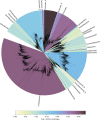This is a preprint.
The Promise and Pitfalls of Prophages
- PMID: 37131798
- PMCID: PMC10153245
- DOI: 10.1101/2023.04.20.537752
The Promise and Pitfalls of Prophages
Abstract
Phages dominate every ecosystem on the planet. While virulent phages sculpt the microbiome by killing their bacterial hosts, temperate phages provide unique growth advantages to their hosts through lysogenic conversion. Many prophages benefit their host, and prophages are responsible for genotypic and phenotypic differences that separate individual microbial strains. However, the microbes also endure a cost to maintain those phages: additional DNA to replicate and proteins to transcribe and translate. We have never quantified those benefits and costs. Here, we analysed over two and a half million prophages from over half a million bacterial genome assemblies. Analysis of the whole dataset and a representative subset of taxonomically diverse bacterial genomes demonstrated that the normalised prophage density was uniform across all bacterial genomes above 2 Mbp. We identified a constant carrying capacity of phage DNA per bacterial DNA. We estimated that each prophage provides cellular services equivalent to approximately 2.4 % of the cell's energy or 0.9 ATP per bp per hour. We demonstrate analytical, taxonomic, geographic, and temporal disparities in identifying prophages in bacterial genomes that provide novel targets for identifying new phages. We anticipate that the benefits bacteria accrue from the presence of prophages balance the energetics involved in supporting prophages. Furthermore, our data will provide a new framework for identifying phages in environmental datasets, diverse bacterial phyla, and from different locations.
Figures





References
-
- Beattie D., Lachnit T., and Dinsdale E. 2017. “Novel SsDNA Viruses Detected in the Virome of Bleached, Habitat-Forming Kelp Ecklonia Radiata.” Frontiers in Marine 4: 441.
Publication types
Grants and funding
LinkOut - more resources
Full Text Sources
Miscellaneous
